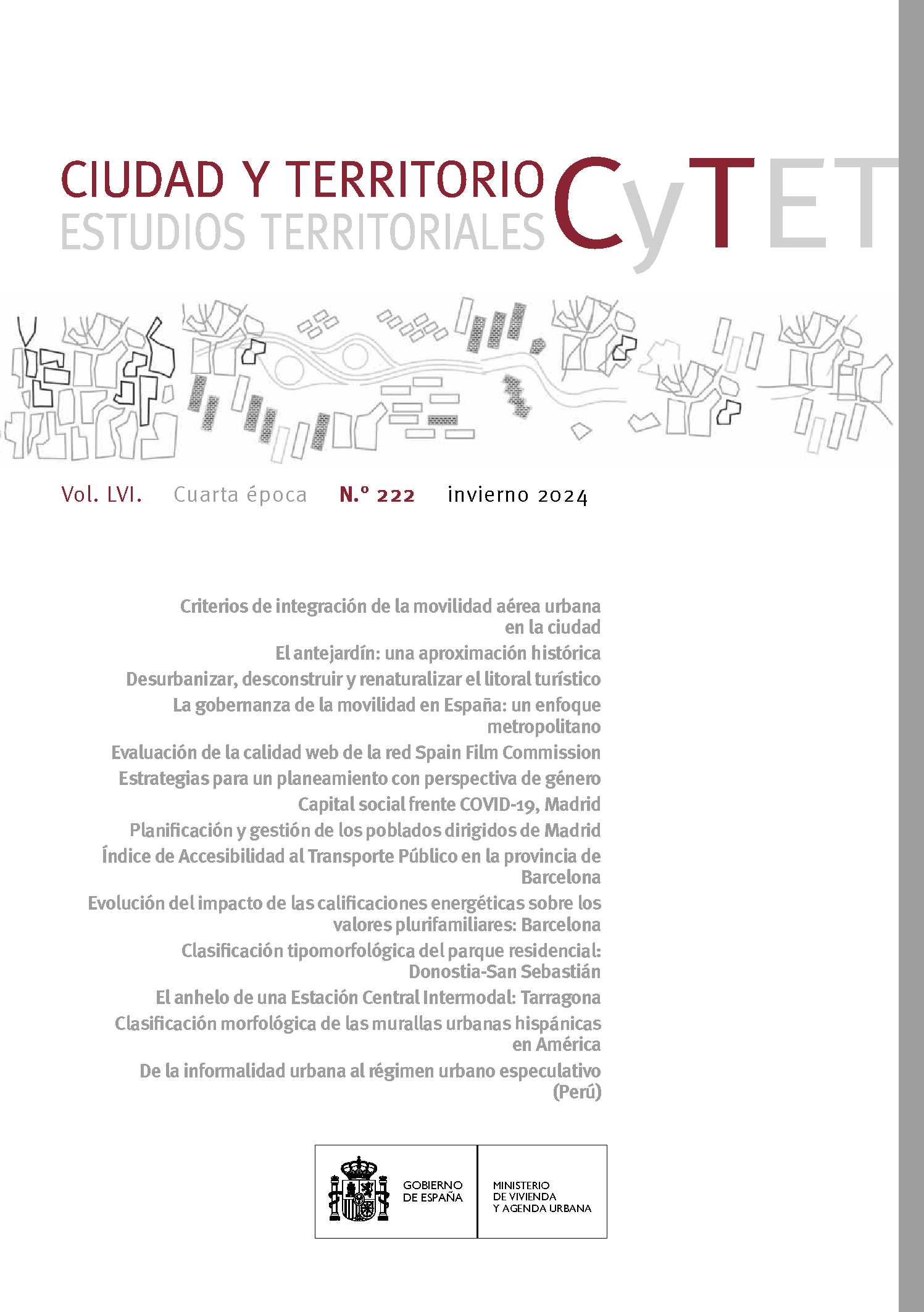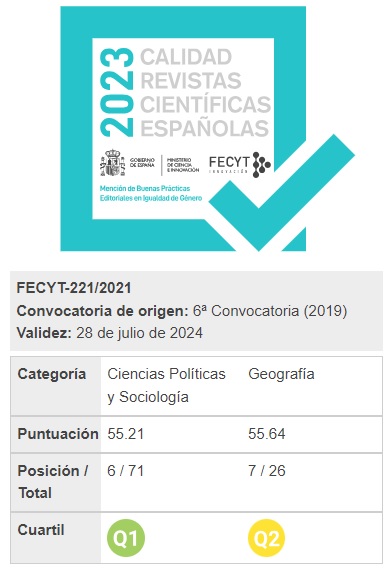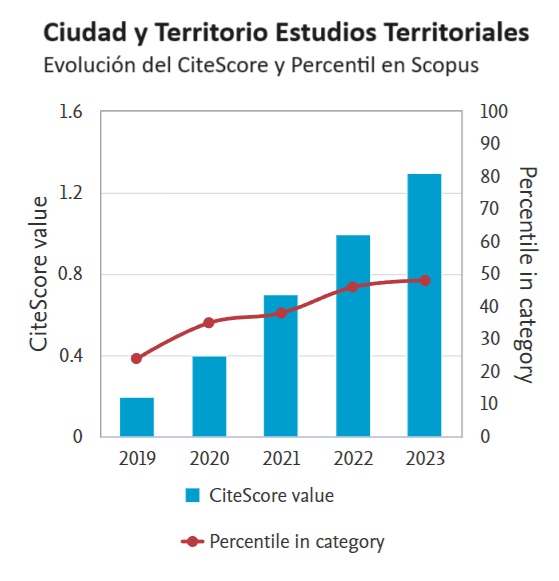Yearning for an Intermodal Central Station: «Ponent-Horta Gran», the most effective Camp de Tarragona Intermodality
DOI:
https://doi.org/10.37230/CyTET.2024.222.12Keywords:
Camp de Tarragona, Central Station, Railway, Intermodal, Horta-GranAbstract
In Tarragona, the Railway Network layout and disputed location of its stations continues to generate controversy, which has been accumulating from XIX century second half. Apparent reason lies in the difficult production of Reus-Tarragona infrastructural link, but a historical, socio-economic and morphological analysis of this proximity of interests and opportunities shows that, if the current triangulation of routes acts as a link, as an excuse and as a basis to take in much of the economic and social development of Camp de Tarragona, the opportunity brought in by the tangencies between these infrastructures can generate a greater connectivity and projection still not acknowledged by local agents. The research concludes that the answer to this demand for interconnections is to explore the most effective intermodality form. And in this sense, the tangency routes around the new urban centrality «Ponent-Horta Gran» freight station have the most effective flow combinations for commuter trains, buses, cars, those of the recently opened railway line and the dynamics of locating a Intermodal Central Station in a more urban environment.
Downloads
References
AYUNTAMIENTO DE TARRAGONA (2022): Avanç del Pla d’Ordenació Urbanística Municipal de Tarragona. https://www.tarragona.cat/lajuntament/poum/avanc-poum
ARTEAGA, I. (2009): Construir ciudad en territorios urbanizados. Transformaciones en la primera periferia. Tesis Doctoral. Director: F. Peremiquel. Barcelona: UPC. Retrieved from https://www.tdx.cat/handle/10803/6971
BARRIACH, F.& VIRGILI, M. E. (2007): Petrófilos. Índex d’articles de Lluís M. Mezquida al Diario Español. Tarragona: Sindicat d’Iniciativa i Turisme de Tarragona.
BELLIDO, S. (1883): Memoria que publica la Junta de las Obras del Puerto haciendo ver los grandes perjuicios que tanto el mismo como el comercio y la ciudad sufren con las actuales estaciones de ferro-carriles y medios que pueden emplearse para remediarlos. Tarragona: Junta de Obras del Puerto de Tarragona.
BELLET, C. & GUTIÉRREZ, A. (2011): Ciudad y ferrocarril en la España del siglo XX. La integración de la alta velocidad ferroviaria en el medio urbano. Boletín de la Asociación de Geógrafos Españoles. (55), pp. 251-279.
BELLET, C. & JURADO, J. (2014): «La localización de las estaciones de Alta Velocidad en España». Revista Anales de Geografía, 34 (2), pp. 9-24. https://doi.org/10.5209/rev_AGUC.2014.v34.n2.47066
BRULL ALABART, J.M. (2014): La tarjeta postal a Tarragona, 100 anys d’història (1887-1996). Tarragona: Arola Editors.
DE ORTUETA HILDERATH, E. (2006): El camí cap a la modernitat. Urbanisme i Arquitectura. Barcelona: Lunwerg.
DE ORTUETA HILDERATH, E. (2021): El paisaje portuario de Tarragona entre la recuperación urbana y la revalorización del patrimonio industrial. Intervenciones en la ciudad y el territorio. Del patrimonio en su diversidad al paisaje cultural. pp. 37-63. http://hdl.handle.net/10662/12652
GENERALITAT DE CATALUNYA (2003): Pla Director Urbanístic de les activitats industrials i turístiques del Camp de Tarragona. https://territori.gencat.cat/ca/01_departament/05_plans/01_planificacio_territorial/plans_urbanistics/plans_directors_urbanistics/pdu_aprovats/Tarragona-i-Terres-de-l-Ebre/pdu_activitats_industrials_i_turistiques_camp_tarragona/
GENERALITAT DE CATALUNYA (2010): Pla Territorial Parcial del Camp de Tarragona.
GÓMEZ ORDÓÑEZ, J. L. (1982): El urbanismo de las obras públicas. Barcelona: Tesis Doctoral, LUB-UPC. Director de tesis, M. Solà-Morales.
PARCERISA BUNDÓ, J. (1986): «Forma General de Ciudad». Revista UR (4), pp. 10-19. https://lub.upc.edu/web/arxiu_LUB/UR_informaciorevista4.html
PARCERISA BUNDÓ, J. (2012): Forma Urbis. Cinco ciudades bajo sospecha. Barcelona: LUB-ETSAB. Universitat Politècnica de Catalunya.
SANTOS GANGES, L. (2011): Urbanismo y Ferrocarril. La construcción del espacio ferroviario en las ciudades medias españolas. Valladolid. Fundación de los Ferrocarriles Españoles.
SOLÀ-MORALES I RUBIÓ, M. (1985): Los problemas de la forma urbana: Tarragona, un enfoque telescópico. Revista UR (1), pp. 44-49. https://lub.upc.edu/web/arxiu_LUB/UR_informaciorevista1.html
SOLÀ-MORALES I RUBIÓ, M. (2009): Un camp de coses (els buits de la metròpolis). Revista AT (19), pp. 3.
ZAGUIRRE FERNÁNDEZ, J. M. (2015): Cuatro escenarios para Entrevías-Tarragona. ¿Cabría una dinámica dominante? Revista [I2] Innovación e Investigación en Arquitectura y Territorio. 3(1), pp. 1-10. https://doi.org/10.14198/i2.2015.3.01
ZAGUIRRE FERNÁNDEZ, J. M. (2017): Vías y Entrevías. Atributos y compromisos del distrito industrial de Tarragona. Tesis Doctoral, UPC, Departament d'Urbanisme i Ordenació del Territori. Director: Josep Parcerisa. Barcelona: ETSAB-UPC. Retrieved from http://hdl.handle.net/2117/113991
ZAGUIRRE FERNÁNDEZ, J. M. (2021): Vías y Entrevías: atributos y compromisos del distrito industrial de Tarragona. Ciudad y Territorio. Estudios Territoriales. 53 (209), pp. 721-740. https://doi.org/10.37230/CyTET.2021.209.07
Published
How to Cite
Issue
Section
License
Copyright (c) 2024 Juan Manuel Zaguirre-Fernández

This work is licensed under a Creative Commons Attribution-NonCommercial-NoDerivatives 4.0 International License.
Considering the provisions of the current legislation on Intellectual Property, and in accordance with them, all authors publishing in CyTET give -in a non-exclusive way and without time limit- to the Ministry of Transport, Mobility and Urban Agenda the rights to disseminate, reproduce, communicate and distribute in any current or future format, on paper or electronic, the original or derived version of their work under a Creative Commons Attribution-NonCommercial-NoDerivative 4.0 license International (CC BY-NC-ND 4.0), as well as to include or assign to third parties the inclusion of its content in national and international indexes, repositories and databases, with reference and recognition in any case of its authorship.
In addition, when sending the work, the author(s) declares that it is an original work in which the sources that have been used are recognized, committing to respect the scientific evidence, to no longer modify the original data and to verify or refute its hypothesis. Author(s) also declare that the essential content of the work has not been previously published nor will it be published in any other publication while it is under evaluation by CyTET; and that it has not been simultaneously sent to another journal.
Authors must sign a Transfer of Rights Form, which will be sent to them from the CyTET Secretariat once the article is accepted for publication.
With the aim of promoting the dissemination of knowledge, CyTET joins the Open Journal Access (OA) movement and delivers all of its content to various national and international indexes, repositories and databases under this protocol; therefore, the submission of a work to be published in the journal presupposes the explicit acceptance by the author of this distribution method.
Authors are encouraged to reproduce and host their work published in CyTET in institutional repositories, web pages, etc. with the intention of contributing to the improvement of the transfer of knowledge and the citation of said works.







